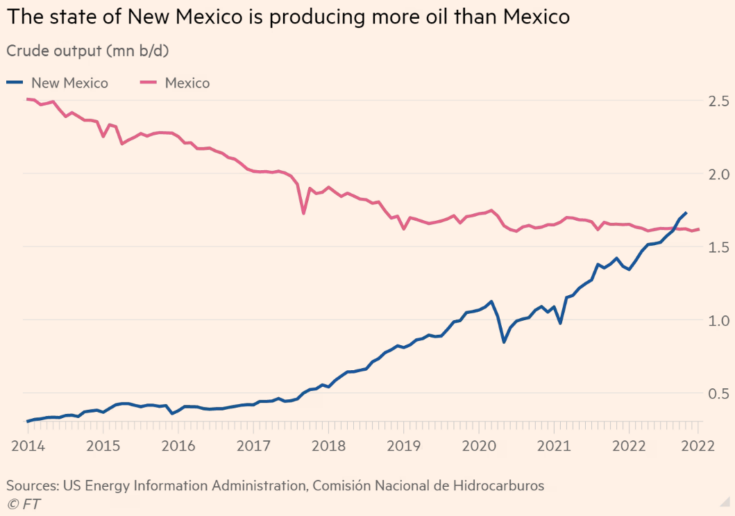Natural Resources Are Overrated
When non-economists discuss the relative wealth of nations, they have a tendency to focus on each country’s endowment of natural resources.

But there’s actually not much evidence that natural resources play a big role, except in a few cases of countries combining low populations with unusually large resource endowments (Kuwait, UAE, Qatar, etc.). Consider this graph from the Financial Times:

That’s quite a striking turnaround, which requires some explanation. A casual reader might assume that New Mexico is unusually well-endowed with oil. In fact, Mexico likely has much larger oil reserves. Instead, New Mexico has aggressively utilized new technologies such as fracking, while Mexican production has stagnated as a result of nationalistic economic policies that favor the highly inefficient state-owned Pemex. More generally, America has not become the world’s largest oil producer because we have unusually large oil reserves, rather we are willing to engage in fracking while many other places (including much of Europe) have banned fracking, or have economic policies that discourage foreign investment.
I often argue that Texas has economic policies that are especially well suited to promoting economic growth, and as a result its population has increased rapidly during recent decades. One response is that Texas is “lucky”, as it is unusually well endowed with oil. But does that argument actually hold up on closer inspection?
When I was young, New Mexico was rarely cited as a major oil producer. Instead, states like Texas, Louisiana, Oklahoma, California and Alaska were the major producers. Since then, fracking has pushed New Mexico and North Dakota into the major leagues, while California and Alaska have slipped a bit as tight environmental regulations make new drilling difficult. So how has population growth fared in these oil states?
Since the 2020 census, California, Louisiana and New Mexico have lost population. North Dakota and Alaska are roughly flat, which means they’ve grown less than the overall US. Oklahoma is up about 1.5%, a bit more than the US (which rose 0.6%), while Texas saw its population soar by roughly 3%. Indeed nearly half of America’s population growth since 2020 has occurred in Texas.
If Texas’s rapid population growth were due to oil, then you’d also expect lots of growth in places like New Mexico and Louisiana. But those states have a less favorable set of government policies. For instance, both places have state income taxes.
The Dakotas provide another example. North Dakota has lots of oil and South Dakota does not. And yet it is South Dakota that has seen rapid population growth in recent years, indeed last year it was at the fifth highest rate among US states. And South Dakota is one of the few states with no (state) income tax.
To summarize, Mexico does not even have economic policies that encourage energy production, much less economic growth. New Mexico does have policies that encourage energy production. But Texas has policies that encourage energy production and also policies that encourage economic growth in a wide range of other industries.
P.S. Which country has more resources, Russia or the Netherlands? Russia has plenty of land, but doesn’t use it wisely. The Netherlands doesn’t have much land—so they made some more.
More By This Author:
About That Employment-Population Ratio
Where Is The Money Going?
A Chat On Supply And Demand



